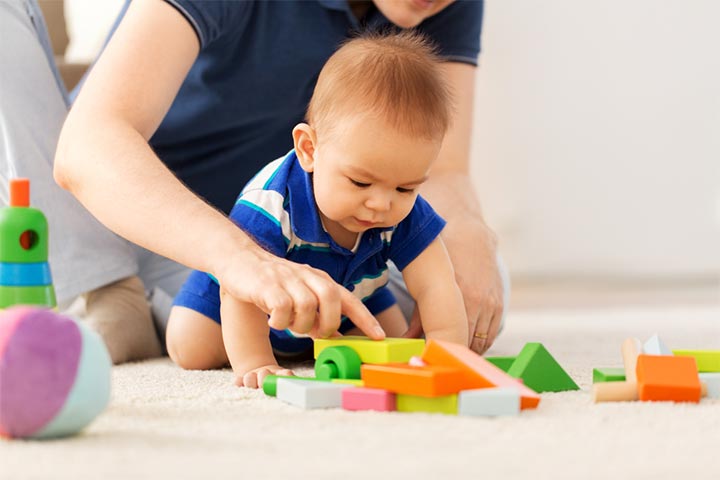Babies and toddlers require adequate physical activity, too, just like older children. As the infant grows older, parents might try assistive exercises for babies and teach them these in relevant ways.
Physical activity promotes a baby’s overall development and growth. It also makes it easier for children to start living an active lifestyle from a young age. This post discusses the relevance of infant exercises and various exercises for different age groups.
Why Do Infants Need Exercise?
Baby exercises could help your little one try different body movements and explore their surroundings better. It may also provide them with the following benefits (1) (2).
- Help build stronger bones, muscles, and joints
- Help your baby’s brains make millions of connections through the development of motor skills
- Improve coordination, balance, flexibility, and range of motion
- Improve their sleep quality and time
- Strengthen various organ systems
- Boost their confidence and social skills when exercises are done with peers
- Physical activity in late infancy may help the baby maintain a healthy BMI
Besides the physical benefits, regular exercise may also contribute to a baby’s cognitive development (3). When a baby is inactive, activities such as reading or telling stories, singing, or painting could also help in cognitive stimulation (4)
Exercise Guidelines For Babies
It is recommended that babies participate in supervised floor-based activities and play from birth to one year. Below are some guidelines that you could follow for baby exercises (5).
- Encourage some amount of physical activity every day, and ensure they get enough crawling time.
- If your baby does not crawl yet, encourage them to grasp, pull, hold, push, or move their head, hands, and feet.
- Ensure your baby gets at least 30 minutes of tummy time every day while awake.
- Once your baby begins to crawl, give them ample safe space to exercise their skills.
- Allow your baby to hold on to stable objects and pull to stand.
- Encourage your baby to reach out for toys during tummy time.
- Encourage a good balance of indoor and outdoor play to enhance their senses.
- Avoid restraining your baby or keep them inactive for more than an hour.
- Ensure there is constant interaction with you as it promotes exploration of their environment.
- Place your infant on a rug or blanket of at least five to seven feet in length during playtime. It helps ensure their safety.
Baby Exercises For Different Ages
The exercise requirements change as your baby grows. The stage-specific exercises help in the growth and development of your baby at a particular age. Here are some exercises for each age group.
Exercises For 0-6 Months
1. Grip the finger
The baby’s grasp reflex, also called palmar reflex, is a primitive reflex that develops in the womb. This reflex disappears around six months of age, and its disappearance signifies the development of the brain’s cortex and motor reflexes (6).
Gripping the finger or reaching and grasping toys helps the baby exercise their palmar grasp, leading to improved fine motor skills (7). It could also help the baby learn more about textures as they learn to hold and feel objects in their hands.
2. Tummy time
It is a popular activity since it keeps your baby active when awake. Tummy time is helpful for your baby’s development as it strengthens the muscles they need to sit and crawl. Many parents begin tummy time as an exercise for their newborn by making the baby lie on their tummy. Encourage tummy time only when your baby is awake, and make sure you do not leave the baby unsupervised (8).Give at least 30 minutes of active tummy time and it can be started as early as three to four weeks of age.
3. Assistive sit-ups
Sit-ups are a great baby exercise. You can assist your little one by holding them by their shoulders and making them stand. Gently move the baby down and bring them back up. The baby will start performing sit-ups.
4. Bicycling
You may have seen many parents cycle their baby’s legs to relieve them from colic, constipation, or gas. This exercise is also great for your baby’s joints, knees, hips, and abdominal muscles. It also improves the flexibility of the legs.
Place your baby on their back and gently move their legs up and down in a motion that resembles the pedaling of a bicycle. Babies usually love this activity, and you can converse with them with coos and smiles.
A mother of three, Sophie demonstrates how she engages her baby in the bicycling exercise to release gas. She believes it is one of the best movements to relieve babies of gas. Sophie says, “What I like to do is a little bit of bicycling and then ever so gently just bring the legs up and push them very gently, and then that releases all the tension (i).”
5. Weight lifting
It is an extension or an advanced version of the grasping exercises for your baby. Once your baby learns to grasp toys and other objects better, encourage them to lift the objects. You can try this exercise around the ages of three to four months. The baby can lift objects placed in front of them while sitting in a high chair or on the floor supported by you. If they seem confused, show them the activity a few times. Show your appreciation when they successfully lift or pick up a toy.
Exercises For 6-12 Months
6. Climb a mountain
This exercise is great for babies who have started crawling. Arrange a few pillows in the form of a small hill on a secure area of the floor. Encourage the baby to crawl over it. This activity helps your baby exercise the joints in their hands and legs.
7. The toe to ear move
This exercise is aimed at strengthening your baby’s core and leg muscles. Lay your baby on their back and keep their legs as straight as possible. Gently move their right toe to touch the left ear and the left toe to touch their right ear. Be gentle and move the limbs within their natural range of motion. Ensure that you are not forcefully stretching the baby’s limbs.
8. Wheelbarrow fun
It is a fun exercise, and most babies enjoy it. Lay your little one on their tummy and slowly lift the lower half of their body while placing your hand on their back. The idea of this exercise is to get your baby to balance their upper body on their arms and hands. Remember to be gentle and place your baby on a soft surface, such as a rug.
9. Assistive baby crunches
It is similar to the crunches adults do, but you do all the hard work for your baby. Lay your baby down on their back, grab their arms, and gently pull them up into a sitting posture. Make sure your baby’s back is upright. Gently lay them down again. Repeat this a few times each day. Pull only with the help of baby’s effort, don’t pull when the baby’s arms are fully extended and against baby’s will.
How To Exercise With Your Baby?
There are many exercises that can benefit you and your baby. You can try them based on your convenience and your baby’s age. Here are some fun ways to exercise with your baby (3).
- Floor exercises at home
- Aqua aerobics in a swimming pool
- Enroll for family playdates or join mom and baby workout groups
- Jog or run with your infant in a jogging stroller
- Go cycling with your baby in a secure baby safety seat
These exercises for babies will help in their overall physical development and also aid in strengthening their muscles. But you should remember that you need to choose the exercise based on your baby’s age and it is best advised to consult a pediatrician before doing so. After that, you can start doing these exercises with your baby and also have a good bonding time while doing so. You must encourage your baby to perform physical activities such as reaching out and grabbing things and include tummy time in their daily routine.
Key Pointers
- Exercise helps babies build stronger bones, develop motor skills, better sleep, improve flexibility, etc.
- You can encourage daily physical activity, provide them enough space to move, and help them adjust both indoors and outdoors.
- Babies need different exercises based on their age; those between zero and six months need grasping practice, whereas those between six and twelve months may enjoy assistive crunches.



















